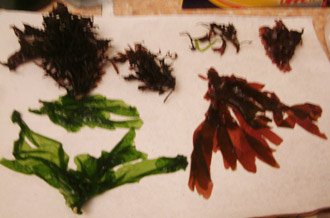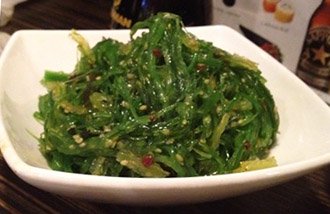Seaweeds
Seaweeds are sea-dwelling, simple forms of plant life in the ocean. They belong to the group of primitive plants known as algae and lack some of the typical structures found in terrestrial plants, such as leaves, stems, and roots.
Similar to terrestrial plants, seaweeds exhibit a wide range of sizes and shapes, influenced by their specific marine habitats. They are indeed intricate marine macroalgae exclusively found in seawater.
 |
| Edible seaweeds. Courtesy: Andrew Eason |
Edible seaweeds
Edible seaweed comprises multi-cellular marine algae and finds extensive consumption in both raw and cooked forms across various cultures, most notably in Japan, China, and other East Asian regions. The practice of seaweed consumption has transcended continents, including the Americas, where it was introduced by the East Asian diaspora.
Almost all edible seaweeds are saltwater algae that typically thrive by adhering to rocks or other solid surfaces along coastal areas.
Classification of seaweeds
Seaweeds can be classified into three broad groups based on their pigmentation:
Brown (Phaeophyceae) seaweeds: They are the most common and large group of seaweeds found worldwide. Laminaria (kombu), and Undaria (wakame) are some of the examples of brown seaweeds. They grow best under cold waters at medium depth.
Red (Rhodophyceae) seaweeds: Porphyra (Nori) and Dulse (Palmiria palmata) are the important edible red algae.
Blue (Chlorophyceae), and Blue-green seaweeds (spirulina).
Brown seaweeds are usually larger in size in comparison to red and green seaweeds.
Seaweeds: A Nutritional Powerhouse
Seaweeds have garnered significant attention in the realm of nutrition for various compelling reasons. They boast a low calorie count while being packed with essential vitamins, minerals, and dietary fibers. As a result, seaweeds are gradually gaining popularity among health-conscious individuals who recognize them as natural, organic, and nutritionally advantageous dietary options.
The tradition of incorporating seaweeds into human diets spans many centuries among the coastal communities of Japan, China, and Korea. While they were originally collected from the wild, there is now a growing trend towards cultivating seaweeds in controlled environments.
Here is an impressive list of edible seaweeds with detailed illustrations of their health benefits and nutrition facts:
The Health Benefits of Seaweeds
Seaweeds serve a vital role as primary producers of marine food.
They are abundant in essential minerals and trace elements such as iodine, magnesium, selenium, sodium, and more.
Seaweeds are recognized as sea-vegetables in many cultures and are consumed for their low-calorie content, along with their rich vitamins, minerals, and dietary fiber.
Since the early 20th century, seaweeds have gained increasing industrial importance, particularly in the production of hydrocolloids such as alginate, agar, and carrageenan. These substances are utilized as thickening and gelling agents in the food processing industry.
In addition to their industrial applications, seaweeds, which have long been used by the Western food industry for their polysaccharide extractives (alginate, carrageenan, and agar), also contain compounds with potential nutritional benefits.
Some seaweed polysaccharides are utilized by the food industry to enhance texture due to their high viscosity and gelling properties. In Asia, seaweeds have been a dietary staple for centuries, featured in salads, soups, and low-calorie dietetic foods.
Seaweeds contain biologically active compounds like phlorotannins, carotenoids, alginic acid, fucoidan, and peptides that have demonstrated significant roles in preventing certain degenerative diseases, including cancer, inflammation, arthritis, diabetes, and hypertension.
Tips for cooking seaweeds

|
| Wakame salad. Photo-Kevin Krejci. |
In Japanese cuisine, seaweeds are traditionally consumed either fresh or sun-dried. While most seaweeds do not require cooking, some thick kelp fronds (Alaria) should be boiled before adding them to soups.
As marine products, seaweeds typically have a high salt content, so it's important to carefully balance the salt in your dishes.
Seaweeds contribute an oceanic, fishy, and salty flavor. Therefore, consuming an excessive amount of seafood in one meal might not appeal to everyone.
Commercially available seaweeds are often soaked in water, and Nori sheets are commonly toasted before being used in sushi rolls. Gentle toasting enhances their flavor.
Concerns About Seaweed Toxicity
Edible saltwater seaweeds can be enjoyed safely in small quantities. However, unlike terrestrial food sources, seaweeds have a tendency to absorb and accumulate heavy metals such as arsenic, lead, cadmium, as well as trace elements like copper, iodine, cobalt, iron, and more.
One specific type of seaweed, Hizikia fusiforme (Hijiki), has been observed to accumulate significant amounts of total arsenic (both organic and inorganic forms). While the Japanese Government reassures its safety, the United States Department of Agriculture (USDA) advises against consuming hijiki seaweed, cautioning that consumption exceeding 4.7 grams per day could potentially lead to arsenic toxicity. (Please note: This information is accompanied by a medical disclaimer.)
≺≺ Back to Home page from Seaweeds.
Further Resources:
Food and Agricultural organisation- A guide to seaweed industry.
Chapter 14 Seaweeds - the United Nations. pdf.